Kalanchoe: description, types and care at home
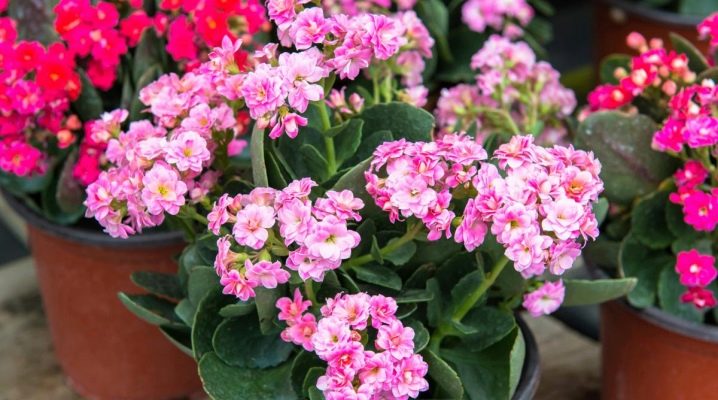
Kalanchoe is an unpretentious and beautiful flower that can be found on the windowsill of many gardeners. Home care is not accompanied by difficulties, but before you start such a plant, you need to study the description and types of this flower.
Peculiarities
Kalanchoe is a flower, the family of which is called Tolstyankov. The homeland of the succulent plant is tropical and subtropical climate. In total, there are over 200 varieties of Kalanchoe. Succulents are a genus of plants that can accumulate water in their foliage and stems. The closest relative of the flower is the bastard.
Many people call the fat woman "money tree", and Kalanchoe - "living tree".
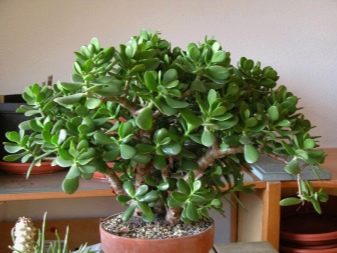
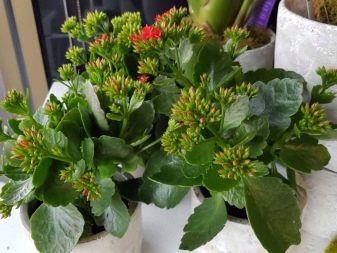
The description shows stems with foliage that are endowed with good juiciness and thickness. Leaves can be of various shapes and are arranged in opposite order. Lobed, serrated and simple foliage is often observed in nature. The bush has flowers of red, purple, green and yellow colors, which can be drooping, erect or four-membered. All of them are large in size.
Outwardly, the "tree of life" is similar to aloe, so many people attribute it to one of the varieties of the famous plant. Both belong to the group of succulents, are almost identical in foliage and are famous for numerous beneficial qualities. But these are completely different types of vegetation that are located in different families.

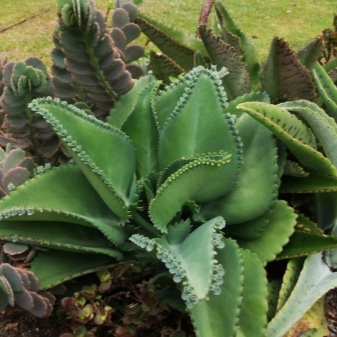
These plants are called by other names: "home doctor", "home ginseng". Such names are justified by the usefulness of the flower: the healing and demand in the medical industry make the plant popular in indoor floriculture.
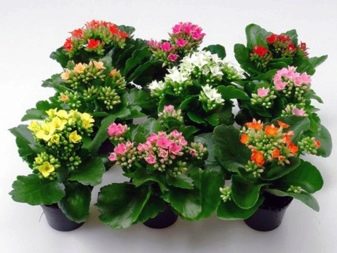
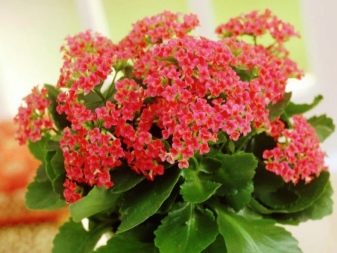
Useful qualities
The flower is endowed following medicinal characteristics.
- The juice extracted from the leaves can be used as an anti-inflammatory agent. Healing nectar does not irritate the mucous membranes and skin. For this reason, it is often used in dentistry and gynecology to speed up the healing process of damaged areas. For example, applying a couple of drops of juice to a breastfeeding woman's nipples can help repair cracks. The entire recovery process will take about 4-5 days.
- The juice will be useful for treating wounds, tropical ulcers, burns, frostbite, bedsores. Stomatitis and tonsillitis will also go away quickly if treated with such a flower.
- In folk medicine, Kalanchoe is actively used to solve problems with the digestive system, to eliminate migraines, during infections, with colds and a suffocating cough.
- Acne, warts, boils will quickly disappear if treated with this plant.
- With its help, you can effectively cope with toothache.
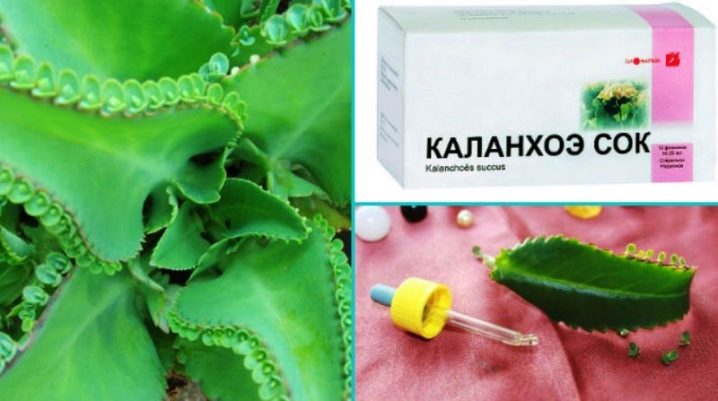
The medicinal properties of Kalanchoe have been scientifically proven, so the plant can be purchased at almost any pharmacy. When using Kalanchoe as a medicine, it should be remembered that any treatment is allowed only after the approval of the attending physician.
Varieties
In total, there are over 200 species of such a plant. However, in indoor growing conditions, you can most often find about 10 varieties.Most of them are famous for the beauty of their flowering, but there are other species that can rarely bloom or simply act as a decorative green flower.
The lobed, or dissected, type of plant is known to many people under the name "antlers". This is a houseplant that initially has straight shoots that will lay down in the future. Due to this quality, such a variety can be grown as ampelous plant varieties. The leaves are fleshy with a deep cut along the contour and are colored in a light green tone. There is a waxy coating on the surface. Flowering is distinguished by numerous yellowish tubular flowers.
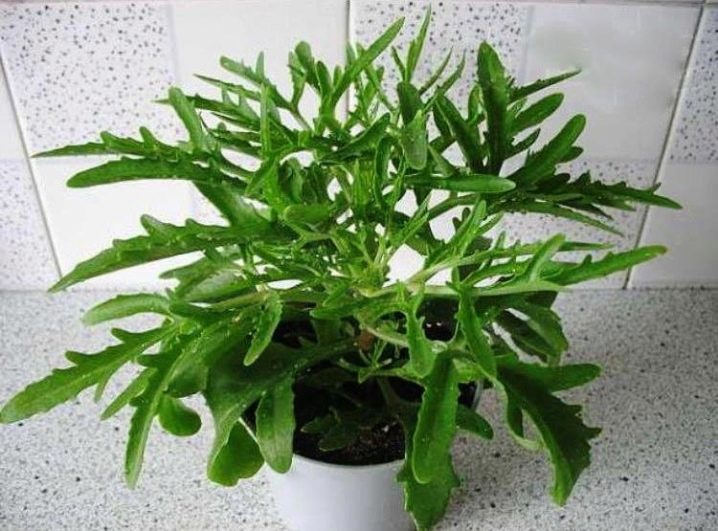
The tube-flowered species is located in the category of dwarf shrubs, reaching 70 cm in height. The succulent plant is adorned with a large number of narrowed and elongated gray-green leaves. The width of the leaves is 0.6 cm, the length can reach 13 cm. There are a large number of buds on the upper part. The plant will delight its owner with red flowers.
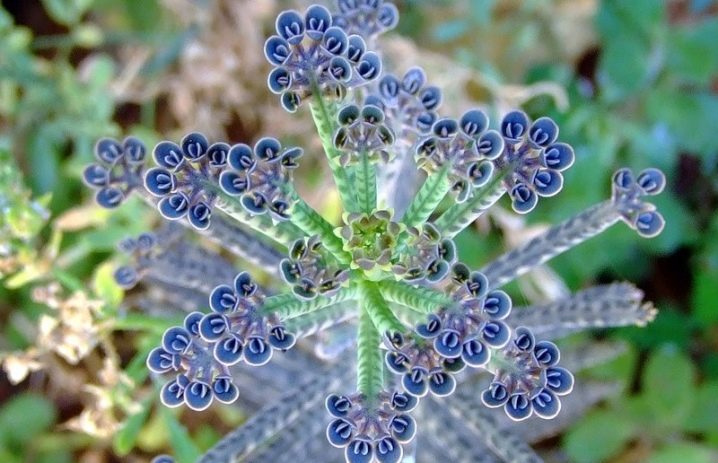
The fiery Kalanchoe is a herbaceous flower with slightly developed branching. The height of the succulent can reach 30-40 cm. The foliage has an obovate shape, the width of which is about 3 cm, and the length is 6-8 cm. The base of the leaves is narrowed. In order for the Kalanchoe to grow properly, it must be placed in a room where a moderate cool climate prevails.
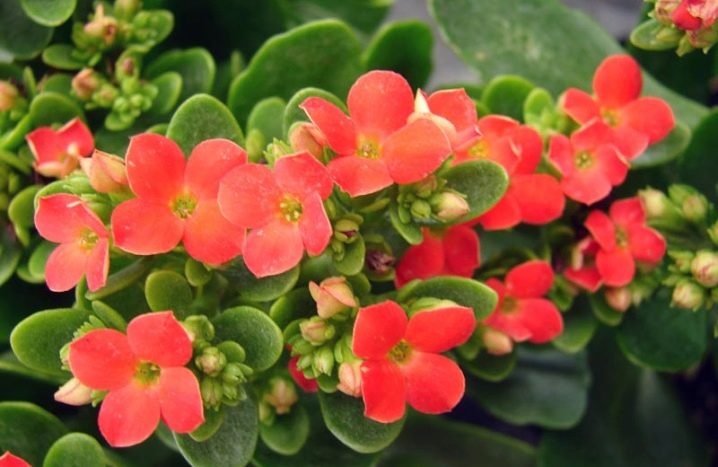
The paniculate-flowered type reaches a height of about 60 cm. It is characterized by thick silvery-white colored leaves. The shape of the leaves is obovate, the width reaches 7 cm, the length is 15 cm. The upper part of the landscaping is smaller and sparse. The inflorescence in its shape looks like a panicle, on which there are yellowish flowers with small rounded petals. Abundant flowering is observed in the spring and falls on April and May days.
Reproduction takes place with the help of bulbous buds, which appear after the flowering period.
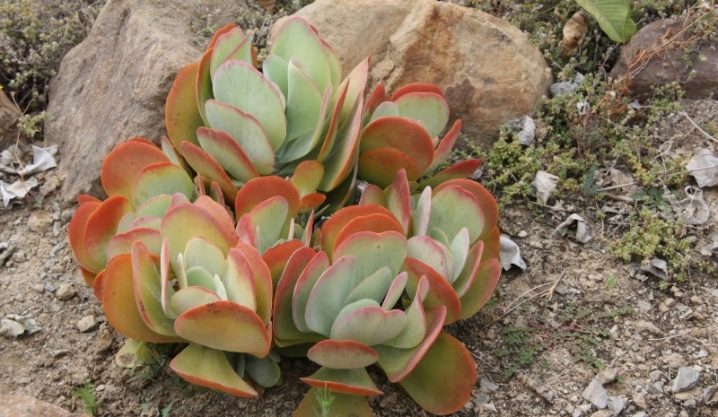
The feathery Kalanchoe reaches one meter in height. It is a perennial herbaceous species with the upper light green foliage of the pinnate type. After some time, the leaves will turn red, jagged along the contour. In the deepening of the denticles, buds are generated, from which small processes with roots will subsequently turn out. From them, with the help of competent care, you can get a new plant.
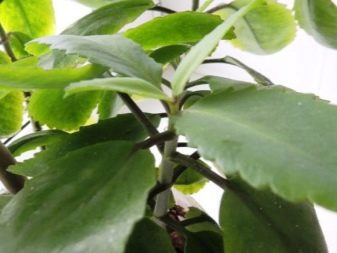
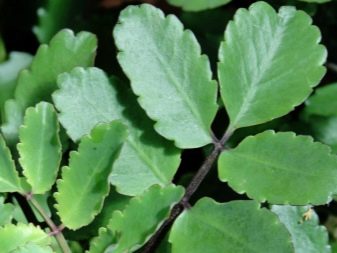
"Bryophyllium Mangina" is a succulent with beautiful pink flowers, shaped like bells. The ampel flower has fleshy foliage and is often found in indoor growing conditions.
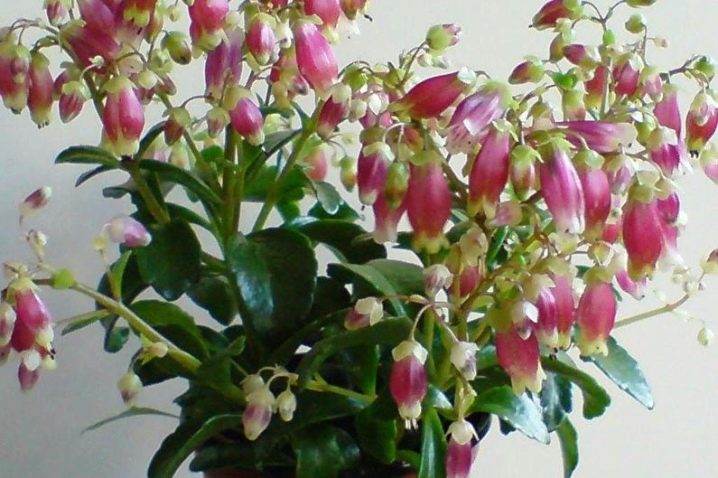
The large-flowered variety can grow up to 60 cm. Light green foliage is located on the roots of short length. When exposed to sunlight, they take on a red tint. Flowering is distinguished by light yellow flowers with a pleasant aroma. The succulent has an umbrella-shaped bloom, on which ovoid petals are located. The plant will bloom well in a moderately cool room.
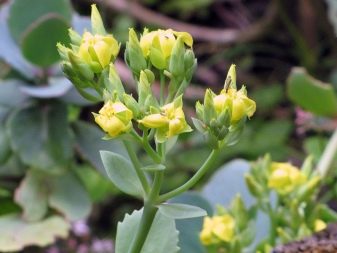
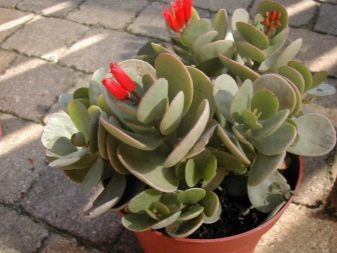
Marble succulent is considered an ornamental shrub up to 50 cm long. The foliage, narrowed near the base, has a notched serration along the edges. On both sides, the leaves have a green color, which turns into a gray shade with large-sized lilac and brown spots. It blooms in white from January to April.
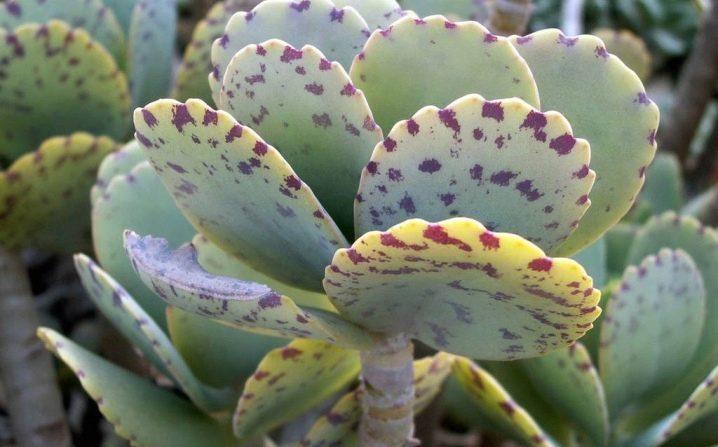
"Don Sergio" is a popular hybrid, which is obtained through the diligence of breeders. It is considered a type of terry Kalanchoe "Blossfeld". The succulent plant is distinguished by beautiful and juicy greens with large double orange inflorescences.
Unpretentiousness and simple reproduction attracts attention from many home gardeners.
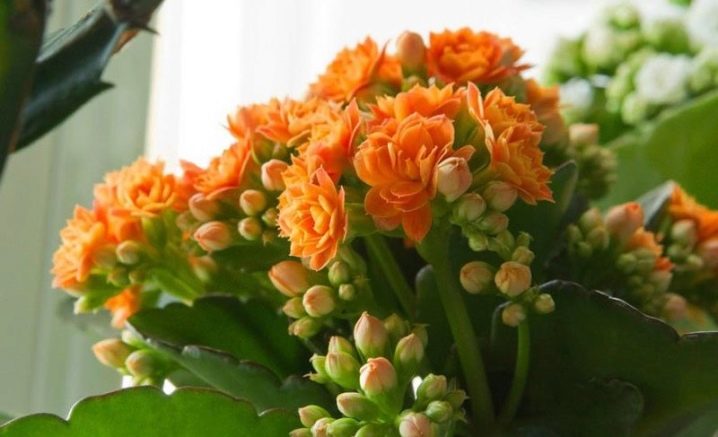
"Brossfeld" is an upright branchy shrub variety up to 30 cm high. Wide green ovoid foliage can reach 7 cm. Flowering is characterized by abundant red flowers, which are located on an umbrella-shaped inflorescence. Flowering occurs throughout the spring.
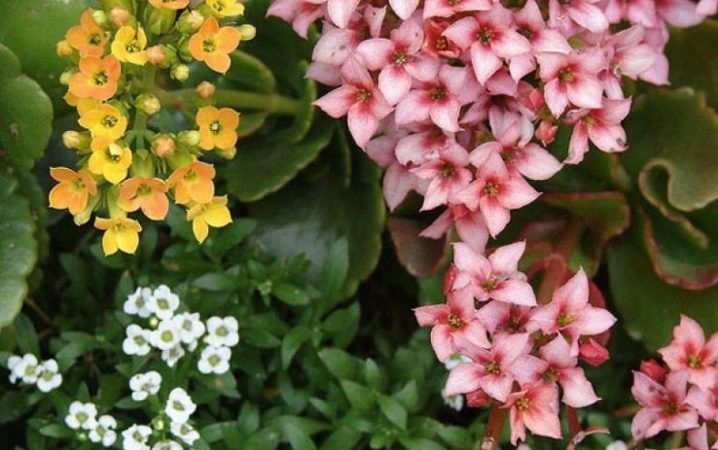
The felt type of Kalanchoe is called "cat ears". It is a succulent plant with erect shoots that are covered with thick hairs. The plant got its name due to the fact that its oblong-ovoid foliage looks like a cat's ears. The length of the leaves reaches 6 cm.
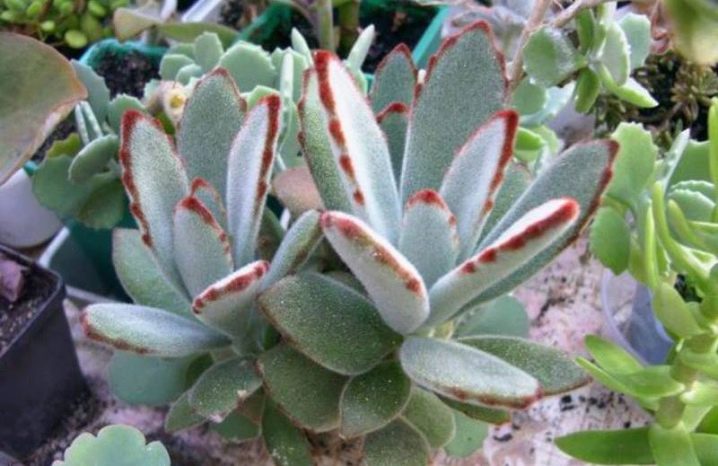
"Bryophyllum Degremona" can grow up to 50 cm. On the stem are bare leaves that roll along the midrib. The upper part of the crown has a gray-green color, the lower one is light green with purple spots. Flowering occurs in winter. At this time, the succulent is covered with pink flowers.
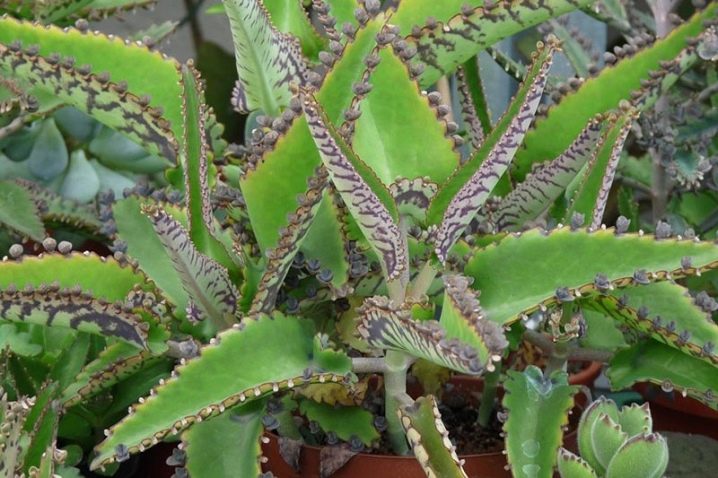
Bekhara Kalanchoe is a well-developed and powerful shrub, characterized by tomentose-pubescent shoots in the upper part. A bare trunk is observed in the lower part of the plant. Kalanchoe blooms with small flowers.
"Benta" is considered a powerful shrub, which has a little branching. Plant height reaches one meter. The foliage is large, rounded. Flowering pleases the eye with white flowers with egg-shaped petals. It takes place between April and May.
Conditions of detention
Despite the fact that Kalanchoe is an unpretentious flower and is able to grow in almost any conditions, it is recommended to study the basic rules for its cultivation. Compliance with the basic conditions will avoid plant diseases.
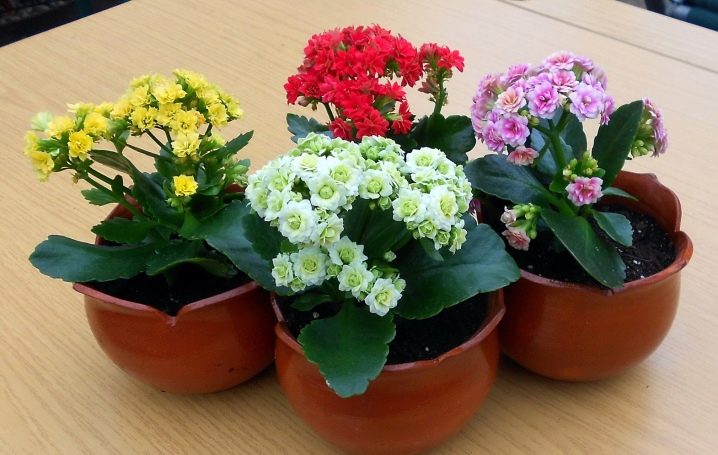
Temperature and humidity
This succulent is able to feel good in almost any temperature regime. However, some standards should be observed. In the summer, it is preferable to observe the regime of 18-28 degrees, and in the winter - 14-18. If the temperature in the room drops below 10 degrees Celsius, the Kalanchoe can become ill and die. During cold wintering (subject to the regime of 14-18 degrees), buds begin to form.
Air humidity for a plant is not particularly important. It will develop well in a warm microclimate, where dry air predominates, but it will not be afraid of high humidity at low temperatures.
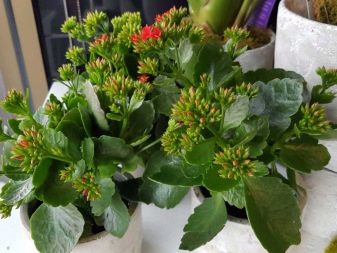
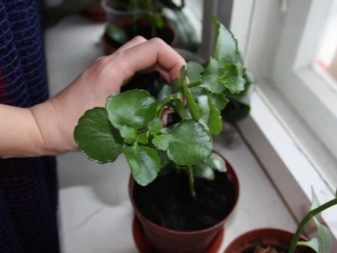
Experienced growers recommend spraying for hygiene purposes. After that, wipe the foliage with a soft cloth or sponge.
Lighting
Daylight hours should be 12 hours. Therefore, in the summer, the flower should be placed on the west or east side. In winter, it is recommended to move the Kalanchoe to the southern windowsill. If it is not possible to provide it with a sufficient amount of light, you should resort to additional lighting. This will require a phytolamp.
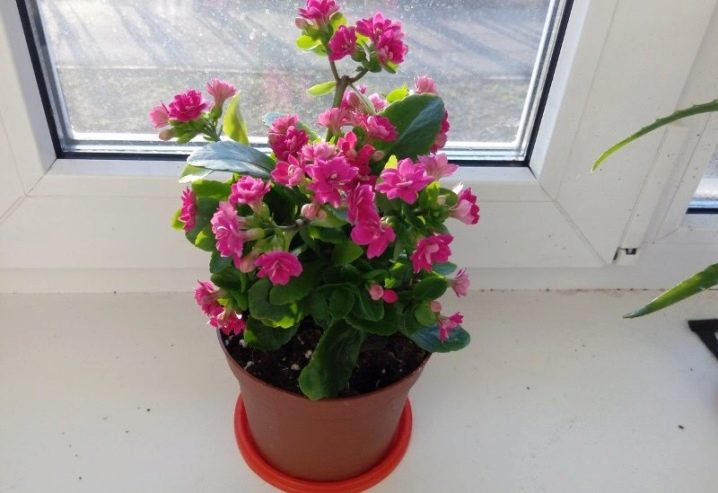
Transfer
In addition to maintaining the correct temperature, humidity and lighting, succulents need a competent transplant. The procedure should be carried out in the spring. Young animals are transplanted annually, and adult specimens are recommended to be moved to a new place once every 2-3 years. It is also worth planting Kalanchoe in a new pot immediately after purchase.
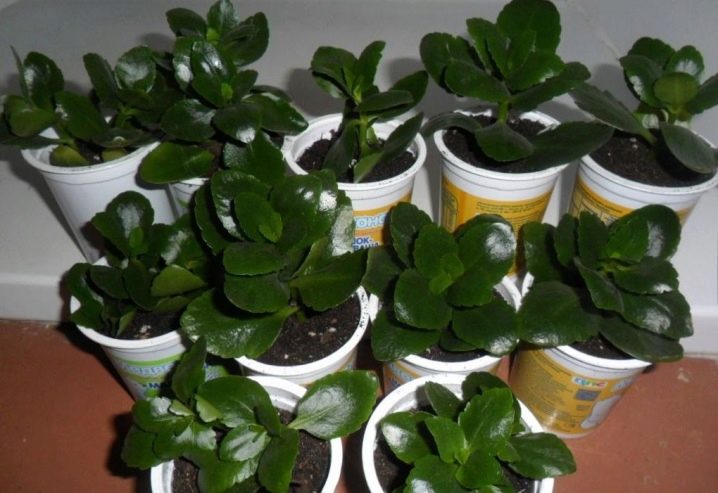
The pot should be correctly sized and more spacious than the previous one. Experienced flower growers advise paying attention to glazed clay options. Such material allows the root system to breathe fully. The thickness of the drainage layer must be more than 2 cm.
It is recommended to choose a soil with an acidity level of pH 5.5-7.0. The best option is a mixture of turf with leafy soil, sand, humus in the same ratio. Do not transplant Kalanchoe during flowering. As a result, you can face this with falling buds and difficult acclimatization.
For this reason, the plant should be repotted after all the flowers wither and the peduncles are cut off.

Soil preparation
During the transportation of a flower for sale, it is located in a coconut substrate with an admixture of peat. This soil is not suitable for growing at home, so you need to replace it. Kalanchoe needs loose soil with the support of an optimal composition for further transplants.
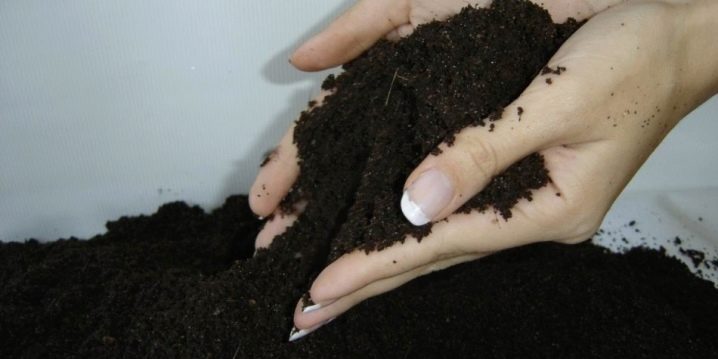
Plant the succulent plant correctly in the soil with the correct acidity level. It can be obtained by adding dolomite or lime type flour. The earthen mixture is obliged to pass moisture with oxygen to the roots, to provide the roots of the plant with sufficient nutrition. Also, it should not contain harmful components.
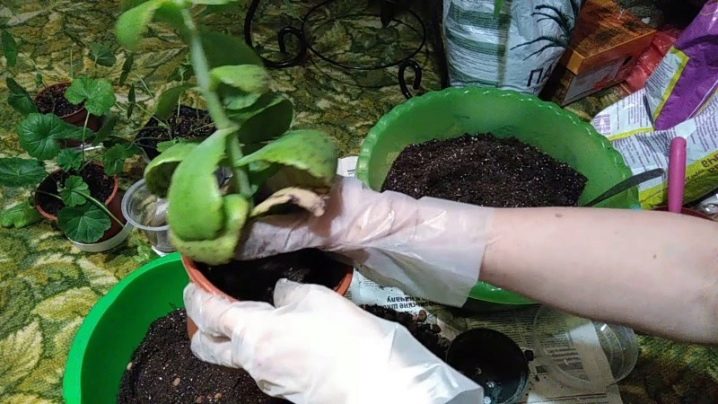
It is recommended to purchase a potting soil mixture for flower plants and add a quarter of the sand to it. You can buy a special soil that targets succulents. Some growers create such land on their own, using the following ingredients in equal proportions:
- garden soil;
- coarse sand;
- humus.
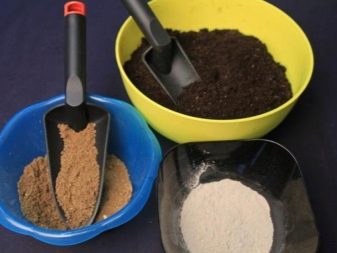
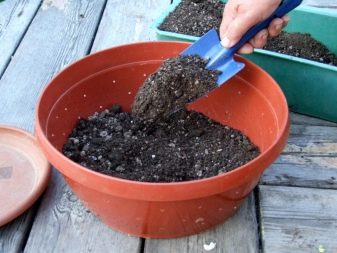
To create ideal conditions, you can add one share of expanded clay or brick chips. Alternatively, you can use crushed coal.
How to transplant correctly?
All actions must be carried out delicately. Before transplanting, it is required to carefully examine the stem with roots. If rot or mold is found, these areas should be removed, and the remaining parts should be treated with crushed coal. If the level of damage has reached the stem part, it is recommended to cut the shoot slightly below the damaged tissue.
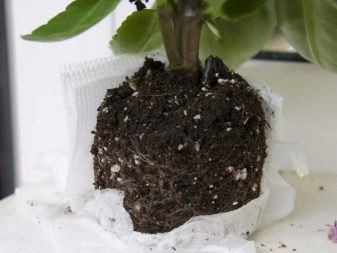
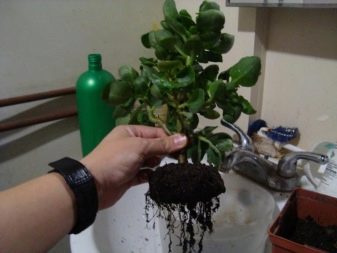
With the help of such actions, you can use the healthy part of the plant as a cutting and transplant the Kalanchoe. The dive should be done with a small amount of soil, without damaging the root system. Before transplanting, the succulent must be watered abundantly. After that, the lump should be carefully moved to the drainage layer sprinkled with earth and fill all the free space around the Kalanchoe with soil. Then you will need to tamp the surface and mulch it with shell rock and fine pebbles or large chips.
How to care?
Kalanchoe is an unpretentious and hardy plant that can be grown in almost any conditions. Even beginner growers are able to cope with the growing process, as this picky flower can forgive most care mistakes.
However, despite the fact that care is simple, you should study the basic rules, thanks to which the Kalanchoe can decorate the house and please its owners with useful properties.
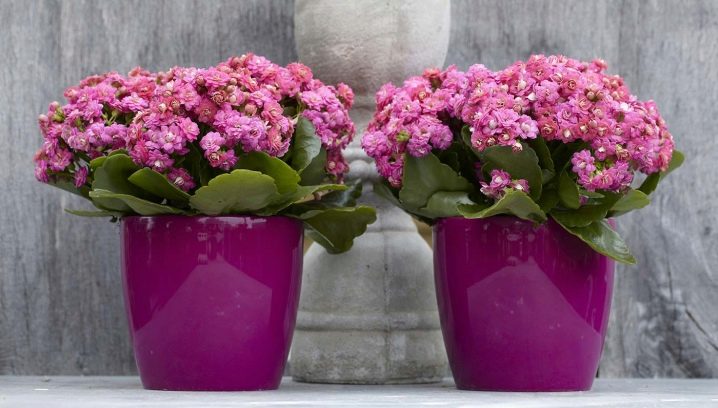
Watering
For watering, you must use warm and soft water that has settled well. The flower should not be watered often, but only after the upper level of the soil has dried. During maintenance, it is necessary to ensure that the soil does not dry out. If it dries completely, the plant will begin to shed its foliage. In winter, Kalanchoe is watered only on the third day after the earthen mixture has dried. Experienced gardeners feed the flower with a pallet.
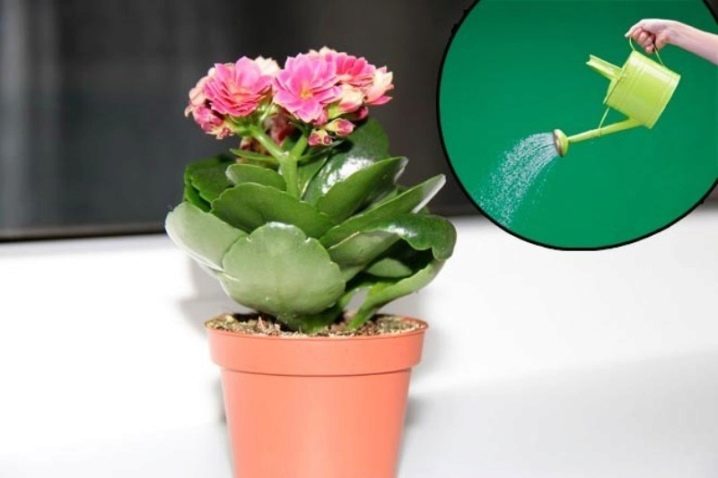
Top dressing and fertilizers
Kalanchoe loves various feeding at home. You can use any additive that is intended for cactus plants. It is recommended to feed it once every couple of weeks after the second decade of May.
It is recommended to continue fertilizing the flower until mid-July. Feeding resumes at the end of autumn.
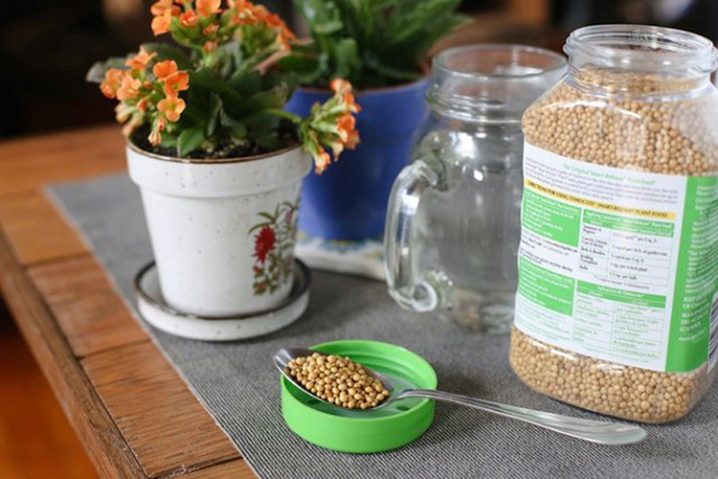
Bloom
As a rule, flowering lasts from November to March. Its duration in rare cases will be less than 4 months. Since Kalanchoe reproduces in most cases vegetatively, it is very difficult to achieve the appearance of flowers.
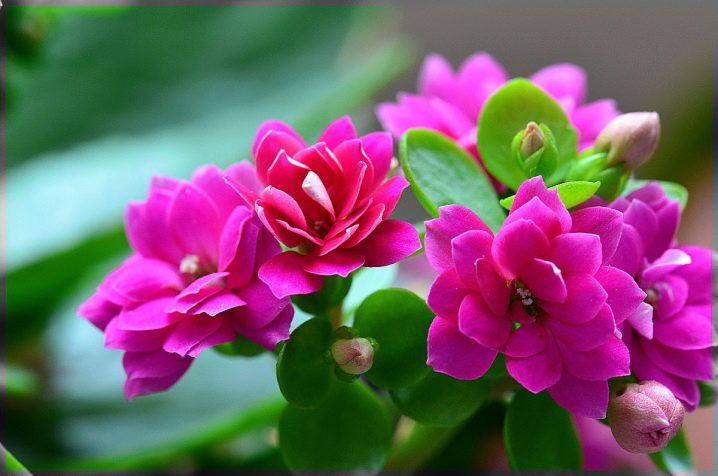
To make the Kalanchoe bloom, you need to remember a few rules:
- compliance with the temperature regime (during the day 25 degrees, at night - 17);
- you need to water the flower twice as often;
- it is important to increase the amount of light, in some cases it will not be possible to do without a phytolamp.
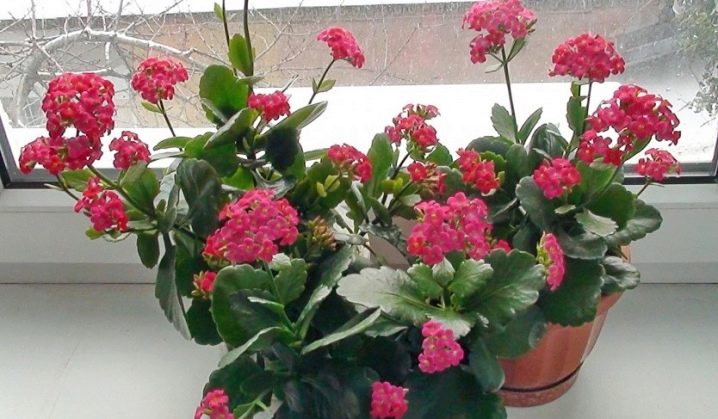
Sometimes, after the succulent has faded, some growers try to get another bloom.Such a procedure is possible, but is not considered recommended, since after it the flower will be able to bloom again only after a few seasons. In most cases, re-blooming is used to separate large plants and plant them in different pots.
This method is considered extreme and is applicable only when the owner does not want to repot a large plant anymore and enjoys constant flowering. Despite the fact that the re-flowering will be almost two times shorter, the number of flowers may exceed their total number from the previous one.
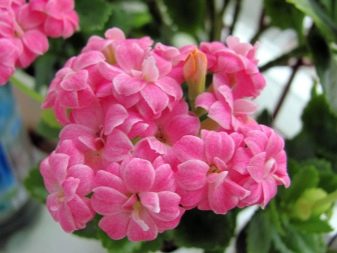

In order for the Kalanchoe to bloom again, you need to create the following conditions for 3-4 weeks:
- temperature regime - 13-14 degrees;
- the duration of daylight hours should not exceed 8 hours.
In winter time
In winter, you need to remember that the plant is tropical, so it will not like the temperature at which the thermometer dropped below 10 degrees. Since winter is the time of flowering, it is recommended to place the flower on the southern side of the house.
Kalanchoe should not be placed near heating devices. Watering should be done infrequently, but more abundantly.
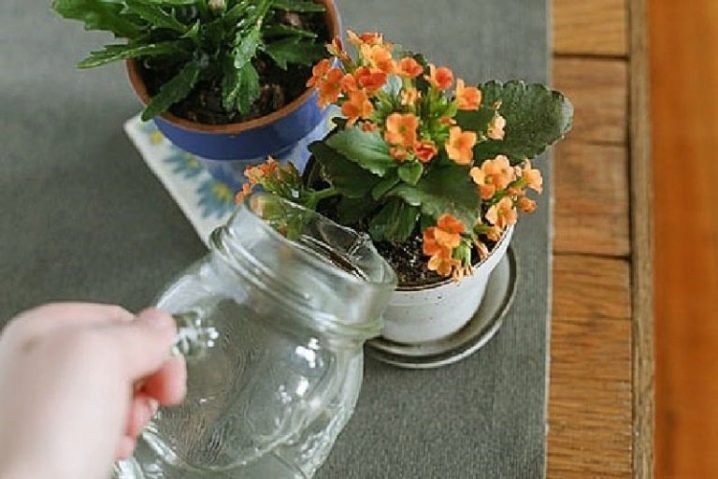
Pruning
Formation is carried out by cutting off long processes. Some varieties of Kalanchoe can have stems that, due to their length, bend over the pot. It is recommended to plant such cuttings along the edges of the pot. After a while, they will be able to take root, grow and hang down attractively.
During flowering, the succulent has a decorative appearance. Non-flowering species will also look attractive hanging from pot holes. You can pinch the plant after it has faded.
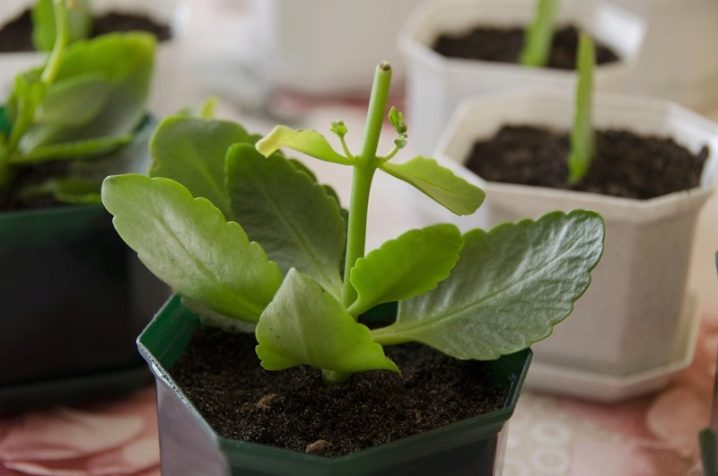
Reproduction
You can get a new plant using seeds, stems, leaf cuttings. Some species reproduce with the help of children. The last option is the simplest. It consists in the fact that the separated children from the mother plant are planted in the ground. After that, the plant begins to grow and develop.
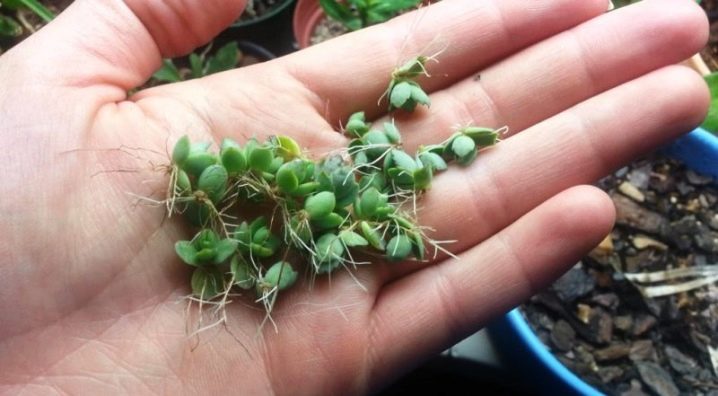
Sheet
This is a simple way in which falling leaves take root. They should be placed in wet sand and covered with a glass. After a while, roots will form and a new plant will begin to develop.
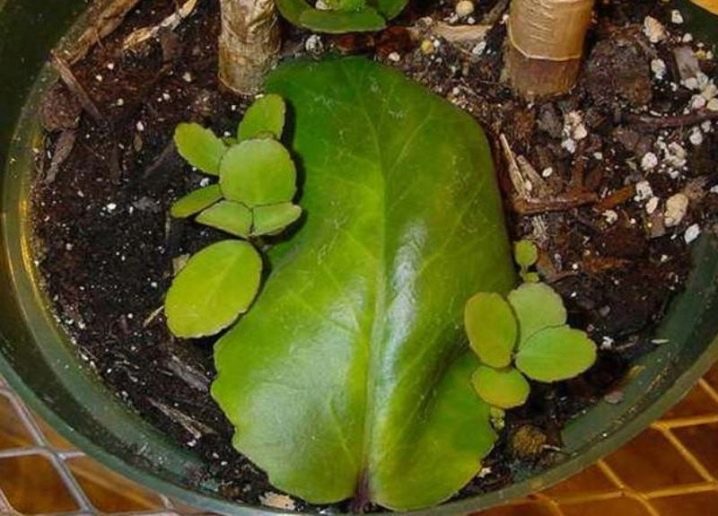
Seeds
You can grow succulent by seed. This is a longer and more difficult process, but almost everyone can handle it. The seeds of the future flower must be sown on moist and light soil and pressed down a little. You do not need to cover them with earth. Then the future Kalanchoe is covered with glass and shaded with paper.
The following conditions must be met:
- temperature regime - 16-18 degrees;
- daily airing 2 times a day;
- timely watering with settled water.
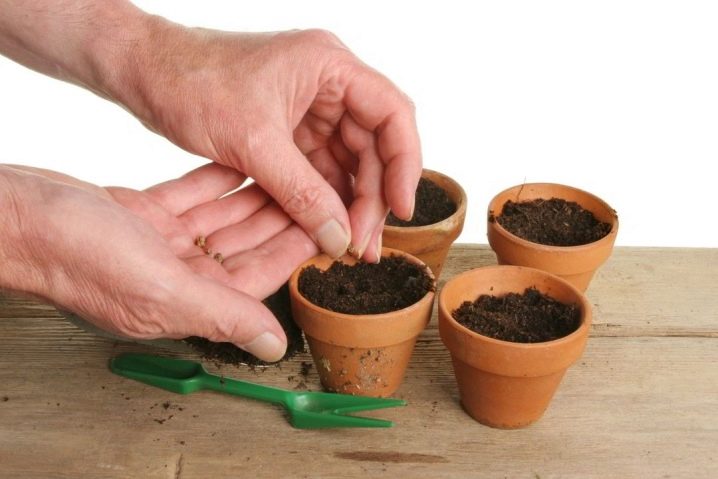
The glass with paper must be removed at the moment when shoots become visible on the surface.
After a month, you can start diving. After that, the seedlings are covered with glass for a couple of days. When several young leaves appear, you can place the Kalanchoe in small containers (a depth of 7 cm will be enough).
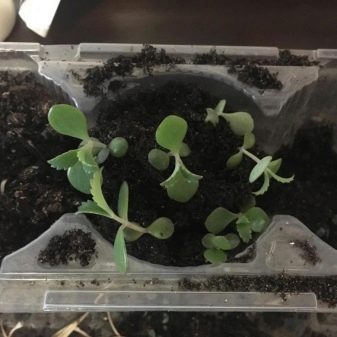
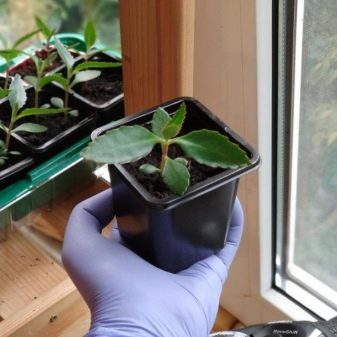
For cultivation, a mixture of turf and deciduous soil with compost and sand is suitable. Its ratio should be 4: 2: 1: 1. To form a bush, you need to pinch the top.
Transplantation of young shoots is carried out in August. To do this, use larger pots that contain humus, compost, deciduous soil and sand.
Kalanchoe grown from seeds will delight you with its flowering after a year.
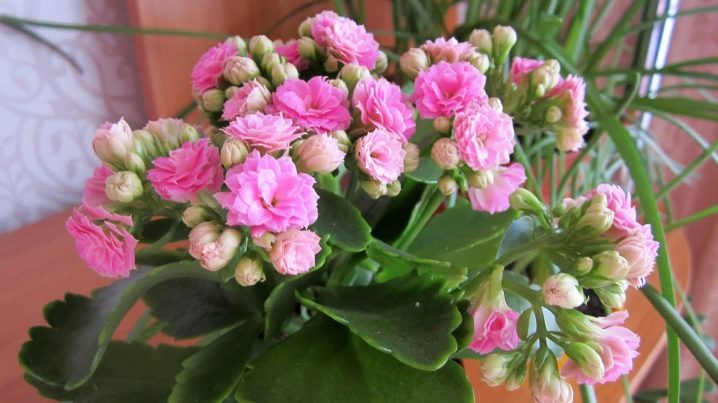
Diseases and pests
These succulents are resistant to many diseases. As a rule, a flower begins to hurt if proper care is neglected. Each Kalanchoe owner should know what to do next if his flower has been attacked by pests.
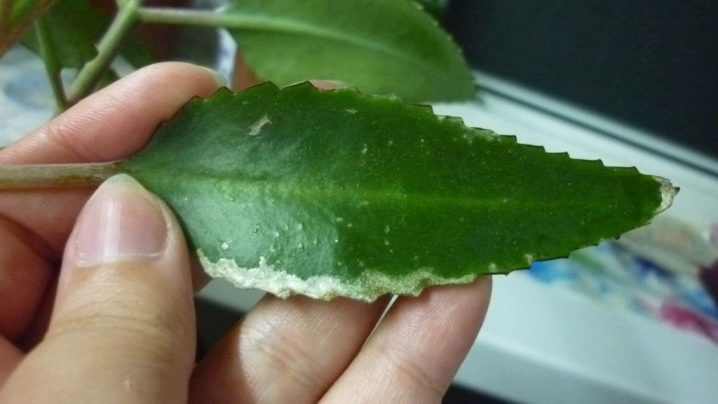
Most often, you can face the following diseases.
- If the flower has acquired a pale shade, this indicates that it is not receiving enough light. Insufficient watering and untimely feeding will lead to the fact that the flower will not bloom.
- The appearance of red spots indicates that the Kalanchoe was attacked by a multi-clawed tick.
- White tubers are the symbol of the mealybug.
- In rare cases, you may encounter aphid attack. For treatment, you can use a cotton pad dipped in an alcohol solution. A similar option is suitable for combating the previously listed parasites.
- When a succulent plant quickly sheds foliage, this indicates a lack of nutrients or the wrong soil. If the lower leaves fall, and the upper ones acquire a yellow color, this means a lack of light. The same phenomenon takes place when the flower is stretched out.
- If the plant looks healthy outwardly, but flowering does not occur, this indicates that the Kalanchoe is receiving too much fertilizer.
- Black spots on foliage are a sign of an attack by parasitic fungi.
- Gray mold occurs when the plant is kept indoors with excess moisture.
- If there is an excess of heat, powdery mildew may appear on the Kalanchoe.

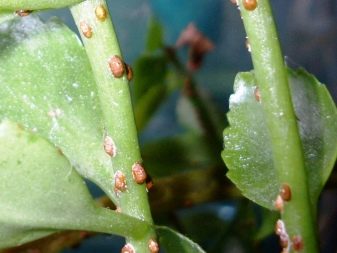
For information on how to care for the Kalanchoe at home, see the next video.





















































The comment was sent successfully.